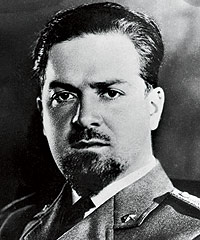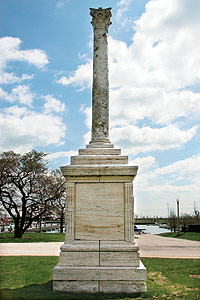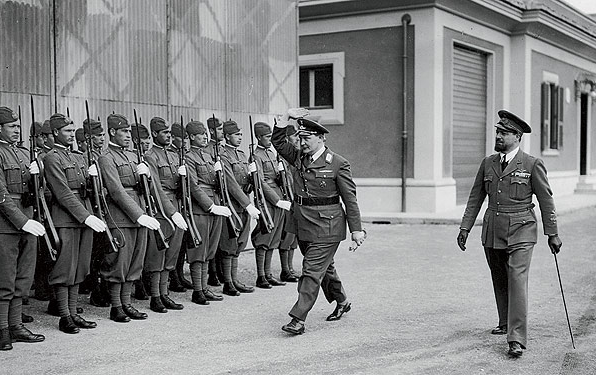When Alderman John Budinger rose from his seat in the City Council chambers one day in the fall of 1946, he held a petition supported by an odd assortment of Chicagoans—businessmen, VFW members, Gold Star mothers, the state PTA. They had a seemingly simple request: Change the name of a street in the heart of Chicago to honor an American hero of World War II, Lt. Com. John Waldron, leader of a famous but doomed attack at the epic battle of Midway. The petitioners assumed their wish would be granted. After all, the street they wanted renamed currently honored a brutal, scheming functionary of a recently defeated World War II foe, the Italian aviator Italo Balbo. But for Chicago's longtime mayor Ed Kelly and his loyal Democratic aldermen, the name change was not that simple.
Thirteen years before, Balbo had led a squad of 24 silver seaplanes on a transatlantic voyage, landing on Lake Michigan during the Chicago World's Fair of 1933, known as the Century of Progress. The pioneering trip caused a sensation, and Kelly capitalized on the excitement by renaming 7th Street in the flier's honor. Now, with an election looming and with the fortunes of the Democratic Party waning, the mayor worried that striking the name of an Italian hero from the street could alienate Chicago's Italian American community.

As the council dithered on the issue, it was bombarded with the opinions of Chicagoans. Groups like the Sons of Italy and the Legione Garibaldi demanded the council keep the name. But the local VFW and some mothers who had lost sons in World War II were part of a far larger faction insisting on the change. The leader of the state PTA admonished the aldermen that Chicago schoolchildren should learn of the "acts and sacrifices" of real American heroes. The Republican candidate for mayor, Russell Root, piled on, saying, "Chicago boys of Italian descent who fought in Italy do not wish to honor the Fascist who betrayed his own people as well as conducted a war against our country." The numbers seemed to favor changing the name.
It didn't happen then—and today, on the 75th anniversary of Balbo's flight, Chicago still honors the Fascist scoundrel. "Movements to change the street name have never gained steam, because the brutal actions of the Italian Fascists are overshadowed in the public's mind by the atrocities committed by Hitler," says Anthony Cardoza, a professor of history at Loyola University. In fact, Balbo Drive is one of three public monuments to the Fascist in Chicago, along with the Balbo column near Soldier Field and a tribute to him on the side of the Columbus Statue at the south end of Grant Park.
Today many Chicagoans know Balbo was a Fascist, but the extent of his villainy is less well known. "Balbo was one of the most violent warlords of the Fascist movement and had a pivotal role in bringing Benito Mussolini to power," Cardoza says. Perhaps if Mayor Kelly had known more about this side of Balbo, these memorials would have disappeared long ago.

After returning home a war hero from the trenches of World War I, Italo Balbo joined Mussolini's Fascist Party. Looking to restore the glory of ancient Rome, the Fascists called for a strong nationalist state with a powerful leader—and no opposition.
The Italian economy was in shambles after the war. Buffeted by criticism from Socialists, Communists, Catholics, and democrats, King Victor Emmanuel III's weak government lived in constant fear of overthrow. Disgusted veterans like Balbo banded into Fascist gangs, the so-called squadristi, that would fight to replace the government with one backing Mussolini.
Balbo's organizational genius and charisma first shone through in the squadristi. Under his leadership, these disorganized bands of hooligans became disciplined paramilitary units. "In a matter of months, the paramilitary forces were responsible for transforming Mussolini's marginal movement into a major national political force," Cardoza says. Through threats, intimidation, and targeted violence against opposition leaders, the squadristi plunged the country into a civil war that killed hundreds and wounded thousands more. Balbo's men used beatings and murder to get their way. Their actions inspired other squadristi to adopt Balbo's battle tactics—and his fighter's uniform: the black shirt.
Smashing the opposition, Balbo ranged over northern Italy, intimidating and assaulting anti-Fascists who stood in his way. In April 1921, he led a raid on a group of Socialists in Venice, conducting a chaotic, nearly hourlong gun battle. A year later, in Parma, brazenly occupying a church steeple, Blackshirts fired on Communists below, and when the smoke cleared, a child was among the dead. Balbo's brash tactics and his willing embrace of violence made him indispensable in Mussolini's eyes. When Mussolini decided the time was right for a coup, he used the threat of a Balbo-led attack on the government in Rome to bully Victor Emmanuel III into capitulation on October 31, 1922.
Balbo continued his crusade against anti-Fascists long after Mussolini came to power. When the Catholic priest and anti-Fascist organizer Don Giovanni Minzoni was brutally clubbed to death in Balbo's hometown of Ferrara, the Blackshirt leader instantly became a prime suspect in the eyes of the local community, although he was never charged.
After 1923, Balbo increasingly turned his attention to flying, achieving international fame as a daring aviator. As minister of the Italian Air Force, he organized the first-ever mass transatlantic flights, one to South America and the second to Chicago during the 1933 world's fair. Balbo's squad of 24 seaplanes, each with a massive engine mounted atop a single wing, received a hero's welcome at Chicago's lakeshore on July 15, 1933. One rapturous Tribune columnist described the "swanlike" landings, called Balbo the "D'Artagnan of the air," and estimated that three million people, including men dressed in homemade Blackshirt uniforms, standing on "roofs, piers, and boulevards and … in crowded windows of skyscrapers," watched the spectacle unfold.
Mayor Kelly, swept up in the excitement, proclaimed the 15th "Italo Balbo Day" and announced that Chicago's 7th Street would be renamed Balbo Drive. The name change was the first in a litany of honors to the Fascist in the five-day hoopla that followed. The Sioux nation declared Balbo a full-blooded member of the tribe, naming him Chief Flying Eagle. Loyola University awarded Balbo an honorary degree.
The celebration of Balbo's squadron was literally carved in stone during his visit. The statue of Christopher Columbus at the corner of Roosevelt Road and Columbus Drive bears an inscription that honors the "wings of Italy" and Italo Balbo. On the statue and the surrounding plaza appears an axe bundled by wooden rods—the fasces, which are the ancient Roman symbol for authority. The fasces gave Mussolini's movement its name and appeared in all of the regime's propaganda. The swastika would serve the same purpose in Hitler's Third Reich.
The five-day stay, which also included a mass at Holy Name Cathedral celebrated by Cardinal Mundelein, ended with a raucous parade down Michigan Avenue in front of one million cheering Chicagoans. Looking to return Chicago's graciousness and perhaps steal the limelight from Balbo, Mussolini later donated an ancient Roman column to the people of Chicago, both to commemorate Balbo's voyage and to symbolize the greatness of Fascist Italy. The uprooted column was dedicated to Balbo's flight in the "eleventh year of the Fascist era." Today, the column—the last remnant of the Century of Progress exhibition in its original spot—is located a few feet off Chicago's lakefront bike path, a mere hundred yards from Soldier Field and adjacent to the Gold Star Memorial, recently constructed to honor Chicago police officers killed in the line of duty.
Nazi luminaries never tired of celebrating Balbo's accomplishments. In August 1938, Balbo visited Adolf Hitler at Hitler's retreat in Berchtesgaden, where Hitler honored him by coming to the door to greet him personally. Nearly two years later, on June 28, 1940, Balbo perished when friendly fire shot down his plane over Libya. Hitler sent a telegram to Mussolini describing Balbo's death as a terrible loss for both the leader and the Italian people. And in a 1942 speech, at the height of the Nazi empire and in the midst of the deadliest war in human history, Hitler harked back to Balbo's success, saying his "brown shirt might perhaps not have arisen without the black shirt."
Over the years, some writers have tried to provide a dose of reality for people wrapped up in the myth of Balbo. In 1983, on the 50th anniversary of the flight, the Chicago Tribune columnist Vernon Jarrett wrote, "Within two years after Balbo's royal treatment in Chicago, the air machine that he built was dropping bombs and turning its machine guns on unarmed Africans during Mussolini's unprovoked invasion of Ethiopia."
But nothing has been done to erase the Balbo name from Chicago. Alderman Budinger's 1946 petition to rename Balbo Drive was sent to the subcommittee on streets and alleys, where it died a quiet death. Lieutenant Com. Waldron did get his memorial, though—a new street just south of Soldier Field, not far from Balbo's monument.
The persistence of the tributes to Balbo puzzles Rand Smith, a professor of politics at Lake Forest College. "That the city of Chicago honors a man who organized thug squads and helped bring Mussolini to power and keep him there is, at best, a gross anomaly and, at worst, a moral outrage," he says. A tourist walking through Rome today would see an occasional building inscribed with Fascist slogans but would not come across a single public monument to Balbo. Visitors to Chicago, an ocean away and Balbo's onetime enemy, can find three.



